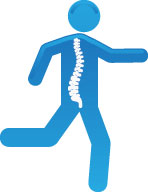Spine
 Spine problems can lead to a variety of symptoms — including severe pain that affects every move you make. You don’t have to live with chronic spine, neck or back pain. Physicians at NeuroSpine can pinpoint the problem and develop a personalized treatment plan to address conditions.
Spine problems can lead to a variety of symptoms — including severe pain that affects every move you make. You don’t have to live with chronic spine, neck or back pain. Physicians at NeuroSpine can pinpoint the problem and develop a personalized treatment plan to address conditions.
Herniated Disc
(Also called Pinched Nerve, Bulging Disc)
In the case of medicine, some doctors use different terms to explain spinal disc pathology. Such is the case of Herniated Disc, Pinched Nerve, Bulging Disc, Ruptured Disc, Torn Disc, Slipped Disc, Collapsed Disc, Disc Protrusion and there are a few others. But, whatever its name, it causes pain. To clarify, the medical diagnosis identifies the cause of a patient’s back, leg, arm or other pain and it is a first step in determining what, if anything, needs to be done about it.
A spinal disc problem can occur in the neck, upper back, middle back, and lower back. It can involve a pinched nerve. That pinched nerve can cause radicular pain (nerve root pain) and cause pain to be referred in other parts of the body. One example is pain from a herniated disc in the lower back can cause leg pain from a pinched nerve, usually diagnosed as sciatica.
If you are experiencing lower leg pain or other symptoms of a herniated disk, you may be eligible to participate in a clinical research study being conducted at our facility. More information about the benefits of voluntary participation is available here.
Degenerated Disc
Degenerated disc is when the disc itself is compromised leading to a disruption of the disc space. That can be a source of pain. It is called axial pain.
A Painful Herniated Disc – Tonya’s Story
Osteoarthritis
Like many medical conditions, medical staff have several terms for this condition: facet joint osteoarthritis and degenerative arthritis are two commonly used alternatives. What causes the pain is, the cartilage between the facet joints in the spine break down. This may lead to formation of bone spurs that may irritate or compress nerves. While at first the pain can be intermittent, it can develop into a steadier stream of pain that may lead to sciatica, in addition to lower back pain.
Symptoms
- back pain
- symptoms develop gradually over time
- symptoms fluctuate between severe and mild-to-none
- lower back pain relief occurs when sitting down
- may cause weakness, numbness, tingling that radiates from the lower back into the buttocks and legs (sciatica)
- leg pain which occurs when walking or standing
- may cause inability to walk far without developing leg pain
Spinal Stenosis
Spinal stenosis is related to the degeneration of the spine and typically becomes an issue in patients 50 years old and older. The most common types of stenosis are: Lumbar stenosis and cervical stenosis.
Lumbar Stenosis
Lumbar stenosis is most common. In this case, the spinal nerve roots in the lower back, are compressed or choked and this can produce a tingling, or weakness or numbness that radiates from the lower back, into the buttocks and legs, especially when walking or being active. In ¾ of the cases, spinal stenosis occurs in the lower back (lumbar spinal stenosis) and most will affect the sciatic nerve, which runs along the back of the leg.
Cervical Spinal Stenosis
Cervical Spinal Stenosis (in the neck) can be more dangerous because it can create a tightening of the spinal cord. This may compromise the coordination of extremities.
Common Stenosis Symptoms:
- heavy feeling or weakness in the legs
- inability to walk long distances or briskly
- intermittent shooting pains into the arms and legs (like an electrical shock)
- gait problems and coordination problems
Pinched Sciatic Nerve Due to Spinal Stenosis – Georges’ Story of Healing
Degenerative Disc Disease
This is one of the most common causes of lower back pain as well as neck pain. Unfortunately it is also one of the most misunderstood. First of all, Degenerative Disc Disease is not a disease, it just describes the symptoms of pain and radiating weakness and/or numbness stemming for a degenerated disc in the neck or back. The term describes the process of the disc degeneration over time. It is a condition that at times, can produce pain from a damaged disc.
Neuropathy Pain
Neuropathy pain is that which results from damage to the nervous system. The most common cause of this kind of pain is spine disorders. Symptoms can include:
- severe, sharp or shooting pain
- deep and burning pain
- persistent numbness
- tingling or weakness that travels into the arms, hands, legs or feet.
Patients can also experience pain resulting from a light touch or other stimulus that typically doesn’t cause pain. Patients can also complain of hypersensitivity to other stimuli.
Scoliosis
A word that’s used to describe an abnormal, sideways curvature of the spine.
Typically, when viewed from the back, a spine is straight. When there is a case of scoliosis, the spine
- Curves to the left as a single curve (when shaped like a ‘C’ it is called levoscoliosis)
- Curves to the right as a single curve (when shaped like a backwards ‘C’ it’s called dextroscoliosis)
- The spine has two curves (shaped like the letter ‘S’)
The most common form of scoliosis in children is called Idiopathic scoliosis. The most common form of scoliosis in adults is called Degenerative Scoliosis.
